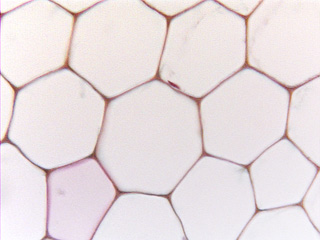 Fig.
3.1-6. Transverse section of stem pith of sunflower (Helianthus).
This parenchyma tissue is unusual in that all the component parenchyma cells
(remember that parenchyma is both a type of cell and a type of tissue) abut each
other with no visible intercellular spaces.
Parenchyma tissue varies from having only tiny intercellular spaces as here, or
much larger ones. Note how straight the cell walls are: all cells are equally
turgid – they must all have the same vacuolar pressure pushing the walls
against each other. If one cell was more pressurized than its neighbors, its
walls would push theirs back – it would be more rounded and the neighbors’
walls would be concave.
Fig.
3.1-6. Transverse section of stem pith of sunflower (Helianthus).
This parenchyma tissue is unusual in that all the component parenchyma cells
(remember that parenchyma is both a type of cell and a type of tissue) abut each
other with no visible intercellular spaces.
Parenchyma tissue varies from having only tiny intercellular spaces as here, or
much larger ones. Note how straight the cell walls are: all cells are equally
turgid – they must all have the same vacuolar pressure pushing the walls
against each other. If one cell was more pressurized than its neighbors, its
walls would push theirs back – it would be more rounded and the neighbors’
walls would be concave.